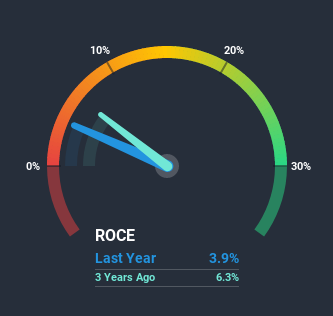Is National HealthCare (NYSEMKT:NHC) Using Capital Effectively?

When it comes to investing, there are some useful financial metrics that can warn us when a business is potentially in trouble. Typically, we'll see the trend of both return on capital employed (ROCE) declining and this usually coincides with a decreasing amount of capital employed. Ultimately this means that the company is earning less per dollar invested and on top of that, it's shrinking its base of capital employed. Having said that, after a brief look, National HealthCare (NYSEMKT:NHC) we aren't filled with optimism, but let's investigate further.
What is Return On Capital Employed (ROCE)?
If you haven't worked with ROCE before, it measures the 'return' (pre-tax profit) a company generates from capital employed in its business. Analysts use this formula to calculate it for National HealthCare:
Return on Capital Employed = Earnings Before Interest and Tax (EBIT) ÷ (Total Assets - Current Liabilities)
0.039 = US$42m ÷ (US$1.3b - US$262m) (Based on the trailing twelve months to June 2020).
So, National HealthCare has an ROCE of 3.9%. In absolute terms, that's a low return and it also under-performs the Healthcare industry average of 9.8%.
View our latest analysis for National HealthCare
While the past is not representative of the future, it can be helpful to know how a company has performed historically, which is why we have this chart above. If you're interested in investigating National HealthCare's past further, check out this free graph of past earnings, revenue and cash flow.
What The Trend Of ROCE Can Tell Us
In terms of National HealthCare's historical ROCE movements, the trend doesn't inspire confidence. To be more specific, the ROCE was 7.8% five years ago, but since then it has dropped noticeably. And on the capital employed front, the business is utilizing roughly the same amount of capital as it was back then. Companies that exhibit these attributes tend to not be shrinking, but they can be mature and facing pressure on their margins from competition. If these trends continue, we wouldn't expect National HealthCare to turn into a multi-bagger.
The Key Takeaway
In summary, it's unfortunate that National HealthCare is generating lower returns from the same amount of capital. In spite of that, the stock has delivered a 16% return to shareholders who held over the last five years. Regardless, we don't like the trends as they are and if they persist, we think you might find better investments elsewhere.
If you want to continue researching National HealthCare, you might be interested to know about the 3 warning signs that our analysis has discovered.
While National HealthCare may not currently earn the highest returns, we've compiled a list of companies that currently earn more than 25% return on equity. Check out this free list here.
This article by Simply Wall St is general in nature. It does not constitute a recommendation to buy or sell any stock, and does not take account of your objectives, or your financial situation. We aim to bring you long-term focused analysis driven by fundamental data. Note that our analysis may not factor in the latest price-sensitive company announcements or qualitative material. Simply Wall St has no position in any stocks mentioned.
Have feedback on this article? Concerned about the content? Get in touch with us directly. Alternatively, email editorial-team@simplywallst.com.

 Yahoo Sport
Yahoo Sport 






































